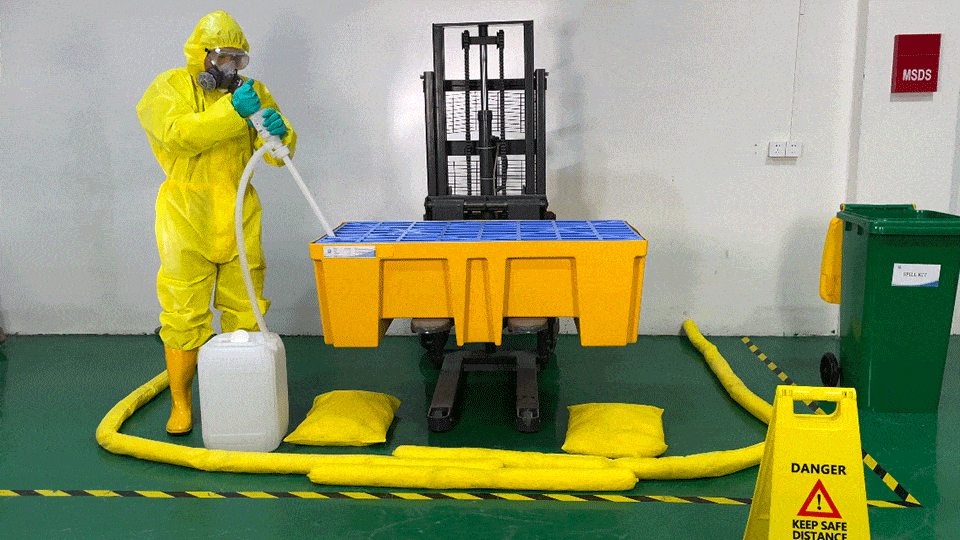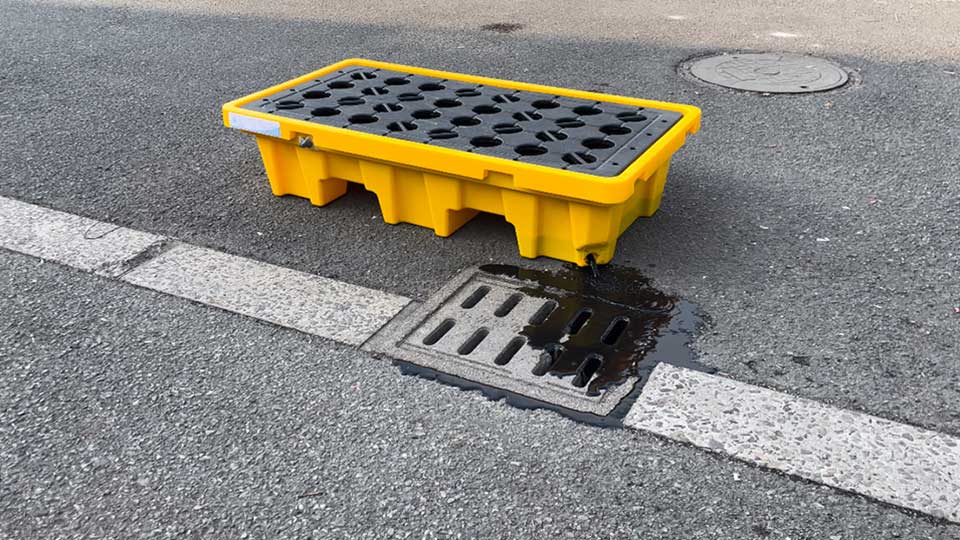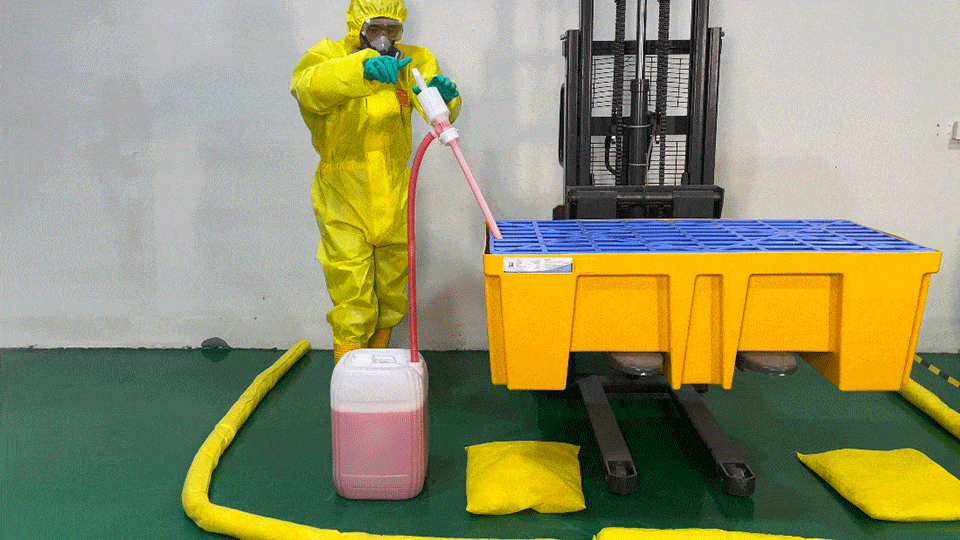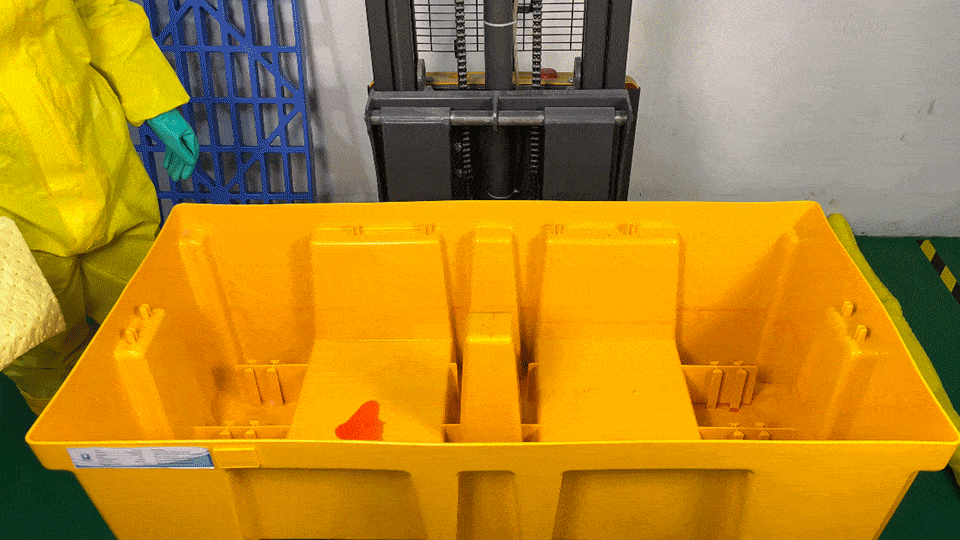
Today we will illustrate how to clean up a spill containment pallet safely by 7 steps.
The target we publish this article: avoid mishandling of spills, secondary leakage and ensure operator’s safety.
This standard procedure is generate by 20 years’ market experience of 1 million spill containment pallets manufacturing and analysis of thousands of spill accidents.
Here we go for the 7 steps:
1. Quick judgment of leakage
2. PPE wearing
3. Suitable tools selection
4. Safely disposal of damaged containers
5. Leakage collection by drain plug
6. Best leakage collection solution
7. Spill containment pallets clean-up
Step #1: Quickly judgment of leakage
When container leaks, we must assess state immediately rather than act in hush-rush way to avoid mishandling.

A. Firstly we need to determine the content of the leaked liquid: It is oil, water-based liquid or chemical, hazardous, or flammable liquid?
By reading the container label or consulting the operating instruction manual/ safety data sheet will likely indicate exactly which type of PPE, spill handling kit, and disposal method is recommended.

B. Then it comes to judgement of situation of damaged container.
Check the leakage is from container tiny cracks, drips, or large holes. Base on the information collect in point A &B, a leakage disposal solution will be generated easily in short time.

Step #2: PPE Wearing
No matter what kind of liquid leaks, we should wear PPE to handle them for safety purposes.
Even direct exposure to non-hazardous greases will cause eye stimulation or skin irritation.
For sulfuric acid liquid, we need corrosion-resistant gloves, protective glasses, boots, eye showers, clothing and masks, etc.

Sometimes we need an emergency safety shower, which can flush water on the acid contacted skin to prevent burns .
By the way: We suggest to wear cotton made close- fitting clothes before PPE putting on since synthetic clothes will become sticky by heat generated by corrosion liquid , which will burn skin.
If people have cotton- made close fitting clothes inside, it plays the role as compartment between skin and PPE. Even the cotton is burnt it is in powder shape rather than sticky compound.
We also need to prepare fire covering sand, fire blanket and other fire extinguishers for flammable liquid.

Now we go to the next step,
Step #3: Suitable tools selection
The tool is to transfer the leaked liquid to a new container safely and effectively and prevent secondary leaks happening.
Here are widely applicable tools:
A new seal-able container to hold the leak and keep the leak sealed— it is is especially important for chemical liquids that are prone to chemical reactions.
Not recommend to apply open containers since they’re easy for secondary leakage, and the molecules of the contained liquid exposure to air might burn or produce toxic gas.

Siphon pump , it transfers the liquid from spill containment pallet to a new container through by atmosphere pressure.
This pump is resistant to oil, acid and alkali, which provides simple and labor-saving liquid collection solution.

Absorbent, which absorbs and contains leaked liquid, and it also can be used to wipe up liquid remaining in spill containment pallet.

Step #4: Safely disposal of damaged container
Before disposing the broken container, we must block an area and remove all production material in this area and forbid unrelated personnel’s entry.
Here is why?
The reason we have this action is to minimize the damage if there is secondary leakage happens.

If the crack on damaged containers is tiny with drips, while the most of liquid stays in original container, we can simply use siphon pump to transfer remaining liquid to new container directly.
But when the container has large cracks or holes, and the remaining liquid in the container is less than a quarter of the total capacity. We need to wait all remaining liquid flowing into spill containment pallet then transfer the liquid.

Step #5: Leakage collection by drain plug
Frankly we do not suggest to simply use drain plug to collect spill liquid unless there is proper equipment . Many manufacturers advertises that drain port can remove leaking fluid, but in real transaction it is not “easy to handle” .
Ideal Drug Plug Solution in Imagination:

Drain Plug in Real Application:

The truth is:
If the operator unplug the drain valve, the liquid in spill containment pallet will all flow to the ground, so there is no need to use secondary container to contain the spills.
Meanwhile there is secondary spill risk to apply spill pallet with plug drain if you do not have some professional knowledge to manage it safely.
Please be sure to operate plug drain spill pallet in accordance with the following instructions :
The used sealing ring may have been deformed during the tightening process. So it can’t be applied in drain plug again in consideration of potential leakage risk.

A. When unplug happens, replace a new drain plug no matter whether it is draining or not.

B. When fixing the plug, pls use proper tooling to fasten it rather by hand.
A & B are in compliance with valve sealing industry regulations.
C. After disposal of damaged container, pull in the forklift and rise the spill containment pallet with liquid. Ensure the spill pallet is 10cm higher than the new container for liquid collection.

D. Move the new container for liquid collection underneath spill containment pallet.
The leaked liquid route out of drain plug is not predictable and changes in pressure, which makes it difficult to prevent liquid drop falling on the ground.
Open mouth buckets could reduce liquid leakage to the ground, but it is not a long term container for liquids.
If apply open bucket as temporary leakage liquid storing station, the operator still needs to transfer the spill liquid to a new sealed bucket, which is a more challenging task rather than drain discharging.
Place a funnel at sealed bucket mouth to expand the liquid collecting area to reduce liquid leakage.

E. Put absorbent socks and absorbent pads under spill containment pallet.
Spill kit should be equipped in case spill happens during the leakage collection to avoid spill flowing out.

F. Use tools to unscrew the plug and drain the leaked liquid to a new container.
When the plug is unscrewed, operator’s exposure to the leaking fluid is unavoidable.

Do wear PPE such as safety glasses, masks, protective gloves, etc.

In fact we do not recommend spill pallet with plug drain for chemical and hazardous liquid storage since there is risk of liquid spray on human body.
Keep in mind that liquid collection container should have enough capacity to keep in all spills.
Can you imagine you need to prepare 2 liquid collection container to manage liquid? The secondary leakage will happen when you change container 1 to container 2.
G. Use absorbent socks and pads to wrap up liquid residue on ground.
Is it different from what your thought of drain plug spill containment pallet?

In fact it is a little complicated.
Here we’d like to recommend the best leakage collection solution.
Step #6: Best leakage collection solution
The siphon pump is the best way to empty the leakage in spill containment pallet and it realizes liquid flowing direction management accurately.

Why do highly recommend siphon pump ?
Here are 4 advantages comparing with drain plug:
1. When emptying the leaked liquid, no liquid and body contact will happen.
The liquid just flow in from suction tube and flow out discharge tube so flow direction is in control .

2. Precisely directed liquid without spill, and no drip will fall on the ground during the whole discharging process.

3. Simple operation and labor-saving.
It is a physical discharging driven be pressure. Ensure the suction tube is in higher position than than discharge tube, pump the handle times then the liquid discharges automatically all the time.

4. It allows changing or adding secondary liquid collection container if operator find the leaks is bigger than original assessment.
Here is how it works.
If the secondary container cannot take over all leakage by one time, just switch off siphon pump. Once another container is ready , switch on pump and the liquid discharging will start again.

There will be no leakage dropping on the ground through the whole process.
We will show you how to operate siphon pump in 3 steps:
A. Raise the spill containment pallet higher than secondary container about 15 cm.

B. Put absorbent socks and pads around spill containment pallet.
This action is to double confirm no drip will fall on floor eve siphon pumps handle leaks safely . We want to prevent accidents so prepare appropriate absorbent materials.
C. Put the suction tube into the liquid in spill pallet and put discharge tube in secondary container . Operate the pump until the siphon happens , then all the leaked liquid is transferred to the secondary container automatically.

For secondary liquid collection container, we recommend plastic bucket with small mouth and airtight lid .
This type of bucket applies for most liquids, and will not spill in moving .
The lid minimize volatility in air and the container body can be labeled for distinguishing.
Our siphon pump show great chemical resistance against oil, acid, alkali, and corrosion. It shows environmental adaptability with spill containment pallet in real operation .
Siphon pump also shows its price competency. In general 2 ea siphon pumps can meet a whole plant spill discharging demand, which is much economical comparing with drain plug solution.
Last not least , here we goes quite important point :
Step #7: Spill containment pallet clean-up
Pls make sure clean up the spill containment pallet for next time usage. If there is residue liquid in pallet, you can use absorbent material to wrap it up .

Wash the spill containment pallet completely to ensure even no solidified residue left .
Label on the spill pallet to show what liquid it used to store since this pallet is not recommended to store other prone liquids.
As last step, if it is a chemical or hazardous liquid leakage, we also need to record it for future reference and similar case avoidance.

By these simple 7 actions, you can manage liquid safely and professionally.
How do you handle spilled fluid? Do you know the requested secondary container capacity by law and regulations? Do you know how to choose a proper spill containment pallet? Pls feel free to message us in comments section below.

